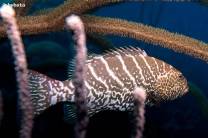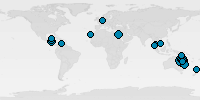
The dive and marine conservation policies in Bonaire have resulted in one of the finest scuba diving and snorkeling destinations.
Take a look at all the pictures!
Recent diving activity from our members
The dive and marine conservation policies in Bonaire have resulted in one of the finest scuba diving and snorkeling destinations.
- North Bonaire
- Kralendijk
Carl's Hill offers diving on top of rich coral gardens and an, in tube sponges covered, drop-off.
- Windsock
- Sharon's Serenity
Bonaire is, compared with its neighbors Aruba and Curacao, the least developed and most remote island of the Lesser Netherlands Antilles. Although tropical it is not the typical white sanded, in palm trees covered, beach destination you might have in mind with a Caribbean island. No, Bonaire is a 60km long and 15km wide arid and scrubby island with most of its shoreline rocky and barren. Bonaire and its capital Kralendijk are located north of Venezuela and are blessed with a mild climate all year long outside the hurricane belt.
Bonaire's best attraction is without doubt the Bonaire Marine Park (1979) consisting out of all beneath the ocean floor and the uninhabited island Little Bonaire (Klein Bonaire). Its protection and conservation is maintained partly because of the Nature Fees that have to be paid for all who would like to enter this phenomenal underwater world. Don Stewart, originally from California, is a famous captain that has made Bonaire one of the Caribbean's best examples of reef conservation. Bonaire has served as an example for the Caribbean eco tourism industry, where spear fishing, shell collecting, and all sorts of extreme fishing methods are forbidden. The underwater hard and soft corals as well as its aquatic life has allowed to grow more dense and in a wider variety because of this strict approach. Other water sports are kayaking, windsurfing, water-skiing, boating and sailing. Also deep sea fishing for bill fish, dorado, amber jack and marlin is popular. The Washington-Slagbaai National Park in the northwest was founded in 1969 and is known for its divi-divi trees, wildlife and birdlife. Other attractions are the Spanish town Rincon, the flamingos near Gotomeer and the Solar Salt Works, Lac Bay and exploring one of its many caves. There are stalagmites, stalactites and you can even snorkel in crystal clear waters beneath the surface. Bonaire is littered with old footpaths, trails that are used both for hiking and mountain biking.
Where Curacao and Aruba are also known to partiers and plenty of beach tourists, Bonaire is known for its superb scuba diving, pretty snorkeling sites and amazing underwater world. Its leeward coastline is edged with fringing coral reefs, wild in colors and with almost all coral reef fish you might find in the Caribbean waters. Its dive sites are marked by large yellow painted rocks with their dive site name on it. Its variety ranges from steep drop-offs, wicked drift dives to shallow coral dives and muck diving.













